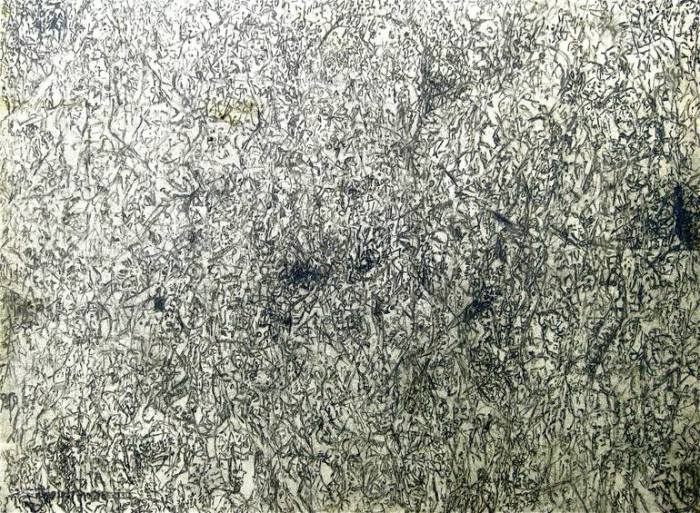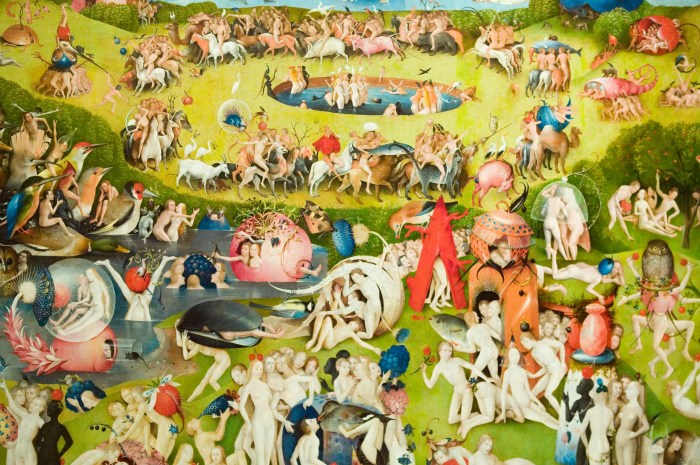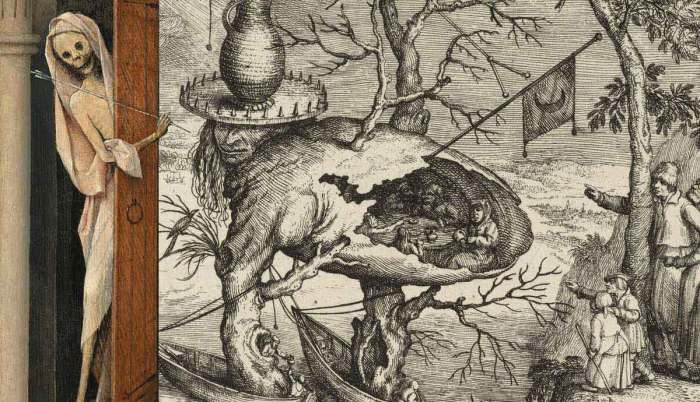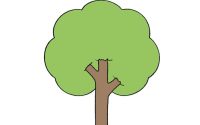Hieronymus Bosch Easy Drawing Simplified Guide
Hieronymus Bosch’s Artistic Style: Hieronymos Bosch Esy Drawing Easy

Hieronymos bosch esy drawing easy – Euy, so you wanna draw like the master himself, Hieronymus Bosch? Adeg-adeg, that’s a challenge! His style is, like,
- super* detailed and kinda freaky, but we can totally simplify it for a more
- easy-peasy* approach. Think of it as a “Bosch-lite” version – still capturing the essence, but way less overwhelming.
Bosch’s style is all about fantastical creatures, bizarre landscapes, and symbolic imagery packed into dense compositions. To simplify his work for drawing, we need to focus on his use of basic shapes and the overall feel, rather than getting bogged down in every tiny detail. It’s about capturing the
vibe*, lah!
Simplifying Complex Bosch Elements into Basic Shapes
The key is to break down those complex figures and scenes into simpler geometric forms. Imagine you’re building with LEGOs – instead of tiny, intricate pieces, you’re using bigger, more manageable blocks. A monstrous creature might be simplified into a combination of circles, ovals, and triangles. A fantastical landscape could be broken down into basic shapes representing hills, trees, and buildings.
Think about the silhouette first – that’s your foundation. Then you can add details gradually.
Reducing Detail While Retaining the Essence of Bosch’s Imagery
For example, take a look at Bosch’s “The Garden of Earthly Delights.” It’s jam-packed with detail, right? But if you focus on the overall composition, you’ll see that it’s basically three large panels with distinct areas. You can simplify this by sketching the overall shapes of each panel, then adding simplified versions of the key elements – like a few stylized figures, simple trees, and suggestive landscapes.
Don’t try to draw every single leaf or feather! Focus on the feeling of chaos and extravagance.
Simplified Drawing Tutorial: The Boschian Bird
Let’s try drawing a simplified Boschian bird. These birds often have elongated bodies, strange beaks, and maybe even a few extra limbs.
1. Start with an oval
This will be the body of your bird.
2. Add a triangle for the beak
Make it long and slightly curved, maybe even a bit pointy. Draw some thin, slightly curved lines for the legs: These can be longer and more spindly than a normal bird’s legs.
4. Add some simple wing shapes
These could be elongated triangles or just a few curved lines.
5. Finish with some details
Maybe add a few simple lines to suggest feathers, or a few dots for eyes. Don’t overdo it!Remember, it’s all about capturing the essence of the creature, not creating a perfect replica. Even a simplified version can convey that distinctly Boschian weirdness. Adeg-adeg, that’s the beauty of it!
Composition and Perspective in Easy Drawings

Euy, so you wanna draw like Bosch, huh? That dude was a trip, man, all those crazy details and swirling compositions. But don’t worry, we can break it down,asli* easy. We’ll make his wild style accessible even for a newbie. Think of it like simplifying a super-spicy rujak – you still get the awesome flavour, just less of a fiery kick.Simplifying Bosch’s chaotic masterpieces into manageable chunks is all about focusing on the core elements.
Instead of trying to replicate every single detail – which,
- duh*, is impossible – we’ll focus on simplifying the overall shapes and forms. Think of it as creating a
- sketsa* (sketch) first, then building up the details gradually. It’s like building a lego castle, you don’t start with the tiny flags, you start with the main towers.
Simplifying Complex Compositions
To tackle Bosch’s busy compositions, we’ll use a method called “sectioning.” Imagine dividing the painting into smaller, manageable squares or rectangles. Each section will contain a specific group of elements. For example, in “The Garden of Earthly Delights,” one section might focus on the central fountain, another on the strange creatures in the background, and another on the dancing figures.
By breaking down the image this way, the whole thing becomes less daunting. It’s like eating a giant pizza – one slice at a time!
Adapting Perspective Techniques for Easy Drawing
Bosch’s perspective isn’t always realistic; sometimes it’s more about creating a surreal, dreamlike atmosphere. Instead of strictly adhering to one-point or two-point perspective, we’ll focus on creating a sense of depth through overlapping shapes and size variations. Smaller objects will be placed further back, while larger ones will be in the foreground. It’s less about mathematical precision and more about conveying a feeling, avibe*.
Think of it as a photo taken with a slightly wonky lens – a bit distorted, but still awesome.
Step-by-Step Guide: Simplified Bosch Landscape
Let’s draw a simplified Bosch-inspired landscape. We’ll use one-point perspective for simplicity.
1. Establish the Horizon Line
Draw a horizontal line across your page, representing the horizon.
2. Vanishing Point
Place a dot on the horizon line – this is your vanishing point.
3. Foreground Elements
Draw a large, oddly shaped rock in the foreground, slightly below the horizon. Add some weirdly shaped trees, close to the rock, using simple shapes.
4. Midground Elements
Draw smaller, more distant rocks and trees, converging towards the vanishing point. Keep the shapes simple, maybe a bit distorted.
While Hieronymus Bosch’s intricate detail presents a challenge for easy drawing, simpler subjects offer a valuable stepping stone for developing artistic skills. Learning to draw basic forms is crucial, and a good starting point might be an easy drawing of a pangolin , focusing on its streamlined shape and overlapping scales. Mastering these fundamental techniques can then be applied to more complex subjects, eventually allowing one to tackle the unique challenges of recreating a Bosch masterpiece.
5. Background Elements
Add a few very small, indistinct shapes to represent distant hills or mountains, barely visible near the vanishing point. Use hazy lines to suggest distance.
6. Add Details
Add some fantastical elements – a tiny house on stilts, a strange bird, or a floating island. Keep it simple, but quirky!This simple landscape uses basic perspective to create depth, but allows for Bosch-inspired whimsicality in the details.
Simplified Composition: Three Key Elements, Hieronymos bosch esy drawing easy
Let’s take “The Garden of Earthly Delights” as an example. We’ll simplify the composition using only three key elements:
1. The Fountain
A central, oddly shaped fountain, possibly with some strange creatures emerging from it.
2. A Strange Creature
One of the many bizarre creatures from the painting, perhaps a hybrid animal with human-like features.
3. A Twisted Tree
A tree with gnarled branches, perhaps reaching towards the sky in an unnatural way.Arrange these three elements on the page, playing with size and overlapping to create a simplified yet evocative composition. Remember, it’s about capturing the essence of Bosch’s style, not replicating it perfectly. It’s all about that
feel*, man!
Illustrative Examples of Simplified Bosch Drawings

Alright, so we’ve talked about Bosch’s style, right? Now let’s get our hands dirty and actually
- draw* some simplified versions. Think of it as a “Bosch for beginners” kinda thing – less detail, more
- vibe*. We’re aiming for that signature Bosch weirdness, but in a way that’s easy to replicate, even if you’re, like,
- totally* new to drawing. It’s all about capturing the essence, not the exact pixel-perfect detail.
A Simplified Bosch-Inspired Creature
Imagine a creature, a mashup of a bird and a lizard, maybe with a bit of a fish thrown in for good measure. Its body is primarily made up of simple ovals and triangles. The bird-like head is a slightly elongated oval, with sharp, triangular beak. The lizard-like body is a series of overlapping ovals, getting smaller towards the tail, which ends in a pointed triangle.
Fish-like fins, made of simple curved lines, sprout from its sides. Line weight varies – thicker lines Artikel the main body parts, thinner lines detail the scales (represented by small, closely packed triangles), and feathery details on the bird-like head. Shading is minimal, using simple cross-hatching to suggest depth and texture, particularly in the scales and feathers.
Think of a muted palette – mostly browns, greens, and blues, with hints of a sickly yellow for added Bosch-ian weirdness. It’s all about suggestion, not hyperrealism.
Creating a Simplified Bosch-Style Landscape
A Bosch landscape is all about strange juxtapositions, right? So, we’ll start with basic shapes. A jagged, triangular mountain in the background, rendered with simple hatching to give it texture. In the foreground, a series of rounded hills, represented by overlapping circles and ovals. A meandering river, a simple squiggly line, snakes through the landscape.
Unusual trees – think twisted, angular shapes – dot the landscape. Their leaves are represented by simple clusters of small circles or irregular blobs. The sky is a simple wash of pale blue, with a few dark, swirling clouds added for drama. The whole thing is done in a limited palette, perhaps muted greens, browns, and blues, creating a slightly unsettling, dreamlike atmosphere.
It’s all about using basic forms to suggest a complex, fantastical world.
Simplified Drawing of a Detail from a Bosch Painting
Let’s take a detail from “The Garden of Earthly Delights,” specifically, one of the bizarre, fantastical fruits. Imagine a pear-shaped fruit, but instead of a smooth skin, it’s covered in tiny, meticulously drawn scales, each one a miniature triangle. The color is a deep, almost unnatural purple, shading it slightly darker at the bottom to suggest roundness. The texture is key here – the small, detailed scales give it a strange, almost reptilian quality.
We’ll use cross-hatching to create the sense of depth and texture within each scale, enhancing the feeling of something both beautiful and unsettling. The background is a simple, flat wash of a contrasting color, perhaps a pale yellow or green, to make the fruit pop.
Simplified Bosch-Inspired Self-Portrait
For a simplified self-portrait, we’ll use Bosch’s signature style. Think exaggerated features, maybe a slightly elongated face, large, expressive eyes, and a slightly unsettling smirk. The lines are bold and slightly uneven, reflecting a certain roughness. We’ll use simple shading techniques, focusing on the contours of the face and the shadows in the eyes to create depth.
The hair is a mass of dark, swirling lines, suggesting a wild, untamed quality. The clothing is simple, perhaps a dark robe with a few rough details, and the background is a simple, flat wash of a dark color. The overall effect should be one of quirky self-awareness, capturing that unique Boschian blend of the bizarre and the captivating.
FAQ Resource
What materials do I need to get started?
Basic drawing pencils (HB, 2B, 4B), an eraser, paper, and colored pencils or paints (optional).
Can I use this method for any of Bosch’s paintings?
Yes, the simplification techniques can be applied to various Bosch paintings, focusing on key elements and motifs.
How important is accuracy to this style of drawing?
The focus is on capturing the feel and essence of Bosch’s style, not precise replication. Stylization is key.
What if I’m not good at drawing?
This guide is designed for beginners. The emphasis is on simplified shapes and techniques, making it accessible to all skill levels.



